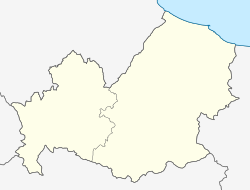
Isernia is a town and comune in the southern Italian region of Molise, and the capital of the province of Isernia.

The province of Campobasso is a province in the Molise region of Italy. Its capital is the city of Campobasso. It covers an area of c. 2,941 square kilometres (1,136 sq mi) and has a total population of 223,871 (2017). There are 84 comuni in the province.

The Pentri were a tribe of the Samnites, and apparently one of the most important of the subdivisions of that nation. According to Salmon, their name shares the same Indo-European root found in the Celtic pen- <peak>. Their capital city was Bovianum Undecumanorum, modern Bojano, in the very heart of the Samnite territory, and it is therefore probable that they occupied the whole of that rugged and mountainous district which extends from the frontiers of Latium, in the valley of the Liris, to those of the Frentani, towards the Adriatic Sea. But it is impossible to determine their exact limits, or to separate their history from that of the remaining Samnites. It is probable, indeed, that, throughout the long wars of the Romans with the Samnites, the Pentri were the leading tribe of the latter people, and always took part in the war, whether specified or not. The only occasion when we hear of their separating themselves from the rest of their countrymen, is during the Second Punic War, when we are told that all the other Samnites, except the Pentri, declared in favour of Hannibal after the battle of Cannae, 216 BC. This is the last occasion on which we find their name in history; all trace of the distinction between them and the other Samnites seems to have been subsequently lost, and their name is not even mentioned by Strabo or Pliny.

Bojano or Boiano is a town and comune in the province of Campobasso, Molise, south-central Italy.

Guglionesi is a town and comune in Molise, southern Italy, about 50 kilometres (31 mi) from Campobasso.

Agnone is a comune in the province of Isernia, in the Molise region of southern Italy, some 53 km (33 mi) northwest of Campobasso. Agnone is known for the manufacture of bells by the Marinelli Bell Foundry. The town of Agnone proper is complemented by other populated centres like Fontesambuco, Villa Canale and Rigaini.
Cantalupo nel Sannio is a town and comune in the province of Isernia, in the Molise region of southern Italy.

Ferrazzano is a town and comune in the province of Campobasso, in the Italian region Molise. It is located 5 km (3 mi) south of Campobasso.

Morcone is a comune (municipality) in the Province of Benevento in the Italian region Campania, located about 70 km northeast of Naples and about 25 km northwest of Benevento. The villages (Contrade) of Morcone include: Canepino, Cuffiano, Coste, Torre, Fuschi, Piana.

Pietraroja is a mountain comune (municipality) in the province of Benevento in Campania, southern Italy. It is approximately 50 km by car from Benevento, in direction north-west, 83 km from Naples in direction north-east and approximately 223 km from Rome in direction south-east.

Casacalenda is a comune (municipality) in the Province of Campobasso in the Italian region Molise, located about 25 kilometres (16 mi) northeast of Campobasso.

Cercemaggiore is a comune (municipality) in the Province of Campobasso in the Italian region Molise, located about 12 kilometres (7 mi) southeast of Campobasso.
Cercepiccola is a comune (municipality) in the Province of Campobasso in the Italian region Molise, located about 11 kilometres (7 mi) south of Campobasso.
Morrone del Sannio is a comune (municipality) in the Province of Campobasso in the Italian region Molise, located about 20 kilometres (12 mi) northeast of Campobasso.
San Giuliano del Sannio is a comune (municipality) in the Province of Campobasso in the Italian region Molise, located about 13 kilometres (8 mi) south of Campobasso.
San Massimo is a comune (municipality) in the Province of Campobasso in the Italian region Molise, located about 25 kilometres (16 mi) southwest of Campobasso, comprising 27.6 square kilometres (10.7 sq mi).
Vinchiaturo is a comune (municipality) in the Province of Campobasso in the Italian region Molise, located about 10 kilometres (6 mi) southwest of Campobasso with a population of 3368 people (31-12-2022).

Frosolone is a comune (municipality) in the Province of Isernia in the Italian region Molise, located about 20 kilometres (12 mi) west of Campobasso and about 20 kilometres (12 mi) east of Isernia. It is one of I Borghi più belli d'Italia. Frosolone is known historically for the production of blades, including knives and scissors, and is home to a museum dedicated to the craft.
Poggio Sannita is a comune (municipality) in the Province of Isernia in the Italian region Molise, located about 30 kilometres (19 mi) northwest of Campobasso and about 25 kilometres (16 mi) northeast of Isernia. Poggio Sannita is on a promontory surrounded by the Verrino and Sente rivers, both mostly torrential in character, especially the latter, which dries up completely during the summer.

In Roman times, Larinum was a thriving and large settlement of ancient origin, located in the hills of the hinterland at an altitude of about 400 m, not far from the coast of the Adriatic Sea, of considerable importance due to its strategic location: it stretched over a large, fertile and flat area, in a strategic position, overlooking the valley floor and the lower course of the Biferno river, and it was also an important road junction, as it was located at the convergence of important road axes, which allowed profitable trade exchanges.

















